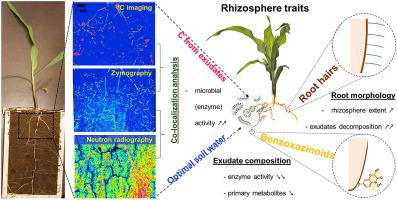Soil Biology and Biochemistry ( IF 9.7 ) Pub Date : 2021-09-16 , DOI: 10.1016/j.soilbio.2021.108426 Nataliya Bilyera 1, 2 , Xuechen Zhang 3 , Patrick Duddek 4, 5 , Lichao Fan 6 , Callum C. Banfield 3 , Steffen Schlüter 7 , Andrea Carminati 4 , Anders Kaestner 8 , Mutez A. Ahmed 5 , Yakov Kuzyakov 6 , Michaela A. Dippold 3, 9 , Sandra Spielvogel 2 , Bahar S. Razavi 1

|
Plants stimulate microbial enzyme production in the rhizosphere, regulating soil organic matter decomposition and nutrient cycling. The availability of labile organic compounds (i.e. exudates) and water is the main prerequisite for such microbial activity and enzyme production, thus shaping the rhizosphere. Root morphology (i.e., root hairs) and exudate composition define the spatial distribution of properties and functions in the rhizosphere. However, the role of root architecture and exudate composition in this spatial self-organization of the rhizosphere remains unknown.
We coupled three in situ imaging approaches: 14C imaging to localize exudates, soil zymography to analyze enzyme activity distribution, and neutron radiography for water fluxes to trace the spatial structure of the rhizosphere of three maize genotypes (wild-type, mutant with defective root-hair prolongation rth3, and mutant with reduced benzoxazinoid content in root exudates bx1). The co-localization of these three soil images revealed the pivotal role of both optimal water content (neutron radiography) and root exudation (14C imaging) for β-glucosidase production by the rhizosphere microbiome and its hydrolytic activity (zymography). Root hairs increased the exudate release and enlarged the spatial extent of increased β-glucosidase activity around the root axis by 35%, leading to a two-fold faster decomposition of 14C exudates compared to the mutant with defective root hairs. In contrast, benzoxazinoids suppressed β-glucosidase activity by 30%, reflecting decreased microbial activity, whereas their absence broadened the rhizosphere. Overall, root hairs in wild-type maize increased microbial activity (i.e. β-glucosidase production), whereas the benzoxazinoids in root exudates suppressed microorganisms.
中文翻译:

玉米基因型特异性渗出策略:增加根际微生物活性的适应性机制
植物刺激根际微生物酶的产生,调节土壤有机质分解和养分循环。不稳定有机化合物(即渗出物)和水的可用性是此类微生物活动和酶生产的主要先决条件,从而塑造根际。根形态(即根毛)和渗出液成分决定了根际特性和功能的空间分布。然而,根系结构和渗出液成分在根际空间自组织中的作用仍然未知。
我们结合了三种原位成像方法:14 C 成像定位渗出液,土壤酶谱分析酶活性分布,中子射线成像水通量追踪三种玉米基因型(野生型、根有缺陷的突变体)根际的空间结构-毛发延长 rth3和根分泌物中苯并恶嗪类物质含量降低的突变体bx1 )。这三个土壤图像的共定位揭示了最佳含水量(中子射线照相术)和根系分泌物的关键作用(14C 成像)用于根际微生物组产生的 β-葡萄糖苷酶及其水解活性(酶谱)。根毛增加渗出物的释放和扩大增加β的空间范围- 35%左右的根轴葡糖苷酶活性,导致的两倍快分解14个Ç渗出物相比,突变体有缺陷的根毛。与此相反,苯并嗪类β抑制-葡糖苷酶活性30%,反映微生物活性降低,而其不存在扩大的根际。总体而言,在野生型玉米根毛增加微生物的活性(即β -葡萄糖苷酶的生产),而在根分泌物的苯并嗪类抑制微生物。


























 京公网安备 11010802027423号
京公网安备 11010802027423号